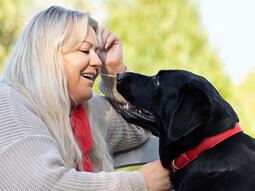
The symptoms of vestibular disease in dogs can be frightening for owners to witness and usually appear very suddenly. Here is what they are and when you should take your dog to the vet.
Have you noticed your dog staggering, leaning to one side with their head tilted as if the world is spinning around them? Lack of coordination, especially in older dogs, is a cause for concern and many worried owners fear that either a stroke or a tumour is behind the strange behaviour.
While these are indeed possible causes and you need to take your pet to the vet as soon as you notice these symptoms, another possible reason why your dog is suddenly wobbly is a syndrome called vestibular disease in dogs. Keep reading to find out what it is, how it manifests and how soon you can expect your pet to get back to their normal self.
What is vestibular disease in dogs?
Most dogs experience a sudden onset of the symptoms. Some of the most common signs of vestibular disease in dogs include:
- Disorientation
- Reluctance to stand up
- Head and/or body tilt to one side
- Walking in circles
- Rapid, repetitive eye movements (nystagmus)
- Imbalance
- Falling over
- Dog vomiting
Unfortunately, these symptoms are not unique to vestibular disease. There are other illnesses that can manifest similarly, including ear infections, strokes and tumours. This is why it’s important to visit the vet so they can rule out other underlying conditions.
What is causing old dog vestibular disease?
Vestibular disease can appear suddenly without any obvious cause. This is why it’s sometimes called idiopathic vestibular disease, meaning there is no specific cause that we have been able to identify. Other causes of vestibular disease in dogs include:
- Under-active thyroid glands
- Ear problems such as infections
- Brain disease including tumours
- Inflammatory diseases
- Head trauma
- Toxic substances found in certain medicines
How is vestibular disease diagnosed?
Sometimes, the presenting systems can be relatively classic for idiopathic or old dog vestibular disease. In these cases, the vet may trial supportive treatment first before offering further diagnostics or referral. Tests that might be recommended include blood tests, urinalysis, or advanced imaging such as CT and MRI.
If the vet is trying to rule out certain other underlying causes, they may also suggest X-rays.
What is the treatment for vestibular disease in dogs?
This depends on whether an underlying cause has been identified and the severity of the symptoms. The vet will often give your dog anti-sickness medication, as symptoms of eye-flickering and lack of balance can make them feel very nauseous. If your dog is refusing food and drink, or vomiting regularly, they may also need to be admitted for IV fluids to avoid dehydration.
If your dog has been diagnosed with a tumour that is causing them to lose balance and coordination, treatment options may include radiotherapy, chemotherapy or surgery to remove the tumour. This will depend on the type of brain tumour and overall prognosis. Find out more about the symptoms and treatment of cancer in dogs with our in-depth article.
Antibiotics or anti-fungals may be prescribed if your dog has been diagnosed with an ear infection. Check out our dog ear problems article to find out more.
Whether a cause has been identified or not, if your dog is struggling with severe dizziness or vomiting, the vet may also prescribe treatment to help alleviate some of the symptoms. This can include sedatives, anti-sickness medication and IV fluids – there are ways to help your pet get through some of the more severe manifestations of vestibular syndrome.
What happens when no cause can be found for your dog’s vestibular disease?
If the blood tests, X-rays and CT scans don’t point to any specific reason for your dog’s symptoms, the vet will likely recommend waiting, as most pets recover without any treatment. The symptoms can start to improve within a couple of days, but will often take at least a few weeks to resolve fully.
In some cases, a slight head tilt or wobble when walking can stay with your dog for life. It is important to keep an eye on how your dog’s condition is evolving, even when no cause has been found. If the symptoms worsen, make sure you contact your vet for advice.
Are you afraid that your dog’s dizziness and lack of coordination may have been triggered by a stroke? Find out more about stroke in dogs, including the most common symptoms and what treatment is available with our handy article.















